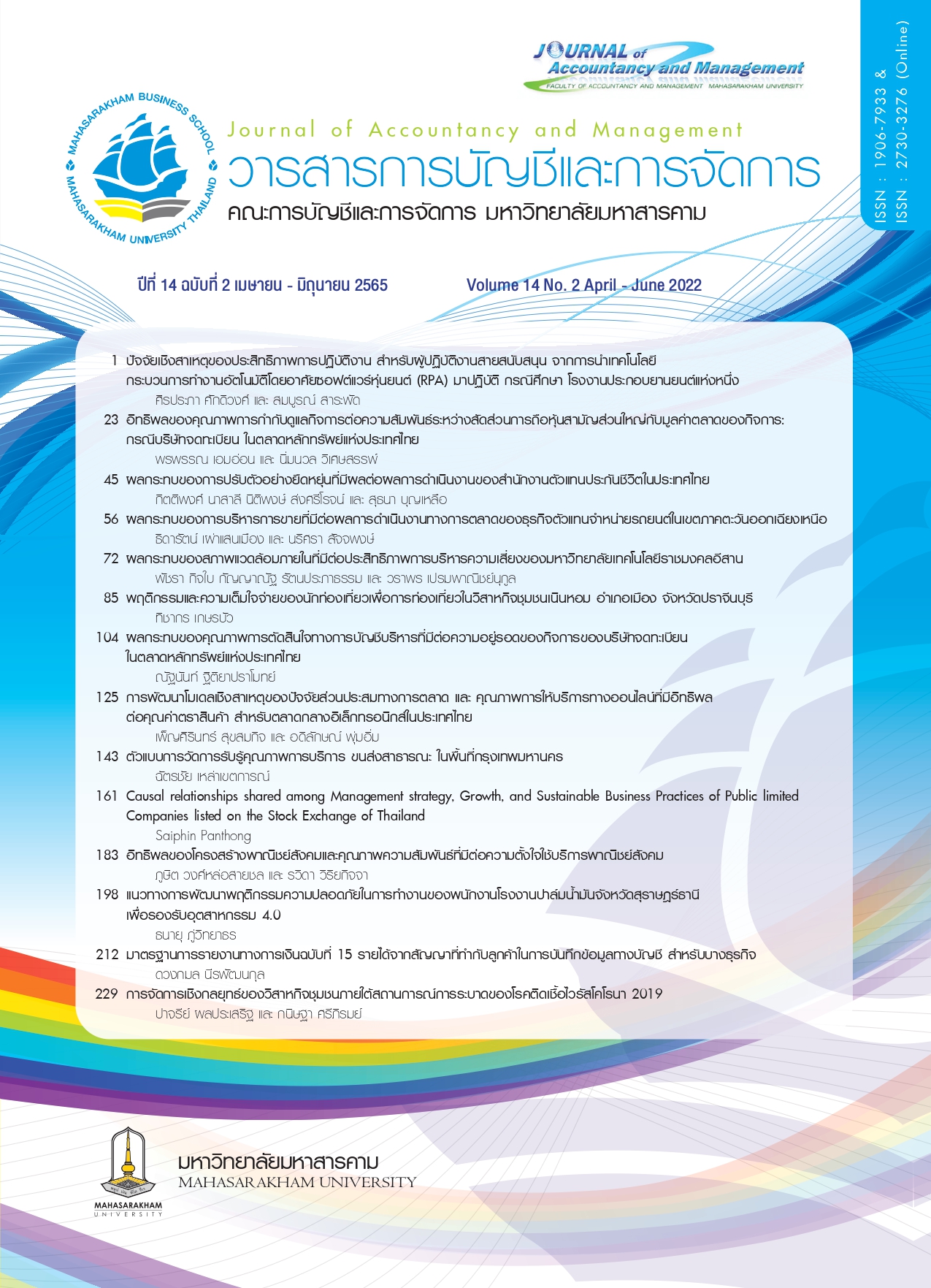ตัวแบบการวัดการรับรู้คุณภาพการบริการ ขนส่งสาธารณะในพื้นที่กรุงเทพมหานคร
Main Article Content
บทคัดย่อ
งานวิจัยชิ้นนี้มีวัตถุประสงค์ เพื่อ 1) สำรวจองค์ประกอบของปัจจัยด้านคุณภาพการบริการขนส่งสาธารณะในพื้นที่กรุงเทพมหานคร 2) เพื่อวิเคราะห์องค์ประกอบของปัจจัยด้านคุณภาพการบริการขนส่งสาธารณะ ในพื้นที่กรุงเทพมหานคร และ 3) เพื่อพัฒนาตัวแบบการวัดการรับรู้คุณภาพการบริการ ขนส่งสาธารณะ ในพื้นที่กรุงเทพมหานคร โดยมีแบบแผนการวิจัยเชิงปริมาณ กลุ่มตัวอย่างที่ใช้ในการวิจัย คือ ผู้ใช้บริการขนส่งสาธารณะ 3 รูปแบบ ได้แก่ 1) ขนส่งสาธารณะทางถนน 2) ขนส่งสาธารณะทางราง และ 3) ขนส่งสาธารณะทางน้ำ ในพื้นที่กรุงเทพมหานคร จำนวน 389 คน เครื่องมือที่ใช้ในการศึกษา คือ แบบสอบถาม สถิติที่ใช้ ได้แก่ ค่าความถี่ ค่าเฉลี่ย ค่าเบี่ยงเบนมาตรฐาน ค่าสัมประสิทธิ์ และการวิเคราะห์องค์ประกอบเชิงสำรวจ
ผลการศึกษา พบว่า องค์ประกอบเชิงสำรวจของคุณภาพการบริการขนส่งสาธารณะ ในพื้นที่กรุงเทพมหานคร แบ่งออกเป็น 2 มิติ ได้แก่ 1) มิติด้านการบริการที่เป็นเลิศ ประกอบด้วยปัจจัย 3 ปัจจัยได้แก่ 1.1) บริการที่ปลอดภัย 1.2) เครื่องมือและอุปกรณ์ และ 1.3) ความรวดเร็วในการบริการ และ 2) มิติด้านความเป็นมืออาชีพ ประกอบด้วยปัจจัย 5 ปัจจัยได้แก่ 2.1)ความเต็มใจในการบริการ 2.2) ความสามารถในการดูแลเอาใจใส่ผู้โดยสาร 2.3) ให้บริการตรงกับสัญญาที่ให้ไว้ 2.4) การรับรู้ความคาดหวังของผู้โดยสาร และ 2.5) การเข้าใจถึงความต้องการของผู้โดยสาร
Downloads
Article Details

อนุญาตภายใต้เงื่อนไข Creative Commons Attribution-NonCommercial-NoDerivatives 4.0 International License.
บทความที่ได้รับการตีพิมพ์เป็นลิขสิทธิ์ของวารสารการบัญชีและการจัดการ
ข้อความที่ปรากฏในบทความแต่ละเรื่องในวารสารวิชาการเล่มนี้เป็นความคิดเห็นส่วนตัวของผู้เขียนแต่ละท่านไม่เกี่ยวข้องกับมหาวิทยาลัยมหาสารคาม และคณาจารย์ท่านอื่นๆในมหาวิทยาลัยฯ แต่อย่างใด ความรับผิดชอบองค์ประกอบทั้งหมดของบทความแต่ละเรื่องเป็นของผู้เขียนแต่ละท่าน หากมีความผิดพลาดใดๆ ผู้เขียนแต่ละท่านจะรับผิดชอบบทความของตนเองแต่ผู้เดียว
เอกสารอ้างอิง
คณะกรรมการการพัฒนาเศรษฐกิจและสังคมแห่งชาติ. (2560). แผนยุทธศาสตร์การพัฒนาระบบโลจิสติกส์ของไทย ฉบับที่ 3 (พ.ศ.2560-2564). กรุงเทพฯ.
ทศพร ไตรเกียรติภูมิ. (2557). การรับรู้คุณภาพการบริการ และแนวโน้มพฤติกรรมของผู้บริโภคต่อโครงการครอบครัวสุขสันต์ กับบริการขนส่งมวลชนกรุงเทพ. มหาวิทยาลัยศรีนครินทรวิโรฒ หลักสูตรบริหารธุรกิจมหาบัณฑิต.
ธานินทร์ ศิลป์จารุ. (2555). การวิจัยและการวิเคราะห์ข้อมูลทางสถิติด้วย SPSS และ AMOS. กรุงเทพฯ : สามัญบิสซิเนสอาร์แอนด์ดี.
นงลักษณ์ วิรัชชัย และสมหวัง พิธิยานุวัฒน์. (2558). ธรรมชาติของศาสตร์ทางการศึกษา และวิธีวิทยาการวิจัยทางการศึกษา. วารสารวิธีวิทยาการวิจัย, 13(2), 33-72.
ภัควัฒน์ อินทรวงษ์โชติ ปภัศร ชัยวัฒน์ ธนัญญา วสุศรี ทวีศักดิ์ กฤษเจริญ และจิรชัย พุทธกุลสมศิริ. (2556). คุณภาพการให้บริการองผู้ประกอบการโลจิสติกส์ประเทศไทยและลาว. วารสารวิจัยและพัฒนา มจธ, 36(4), 465-475.
ศิริวรรณ ไชยสูรยกายต์ และศรันย์ ดั่นสถิต. (2564). การประเมินคุณภาพการให้บริการของท่าอากาศยานสุวรรณภูมิ จากความคิดเห็นในสื่อสังคมออนไลน์ด้วย Importance-performance Analysis. วารสารการบัญชีและการจัดการ, 13(2), 93-108.
สุวิมล ว่องวาณิช และนงลักษณ์ วิรัชชัย. (2542). การวิเคราะห์เปรียบเทียบผลการจัดอันดับมหาวิทยาลัยของประเทศ ในเอเชียปี 2540-2542. วารสารวิธีวิทยาการวิจัย, 14(3), 335-351.
สำนักยุทธศาสตร์และประเมินผล กรุงเทพมหานคร. (2556). แผนการบริหารราชการกรุงเทพมหานคร พ.ศ.2556-2560. ค้นเมื่อ1 เมษายน 2563 จาก http://one.bangkok.go.th/info/bmainfo/docs/plans/2Management%20Plan%20governor%202556-2560.pdf.
อัณณ์ภิศา ราร่องคำ. (2562). ความคิดสร้างสรรค์ในการปฏิบัติงานกับคุณภาพการบริการของพนักงานสายสนับสนุน มหาวิทยาลัยมหาสารคาม. วารสารการบัญชีและการจัดการ, 11(3), 144-154.
Bakti, I. G. M. Y., & Sumaedi, S. (2015). P-TRANSQUAL: a service quality model of public land transport services. International Journal of Quality & Reliability Management, 32(6), 534-558.
Caro, L. M., & Garcia, J. A. M. (2008). Developing a multidimensional and hierarchical service quality model for the travel agency industry. Tourism Management, 29(4), 706-720.
Grönroos, C. (1984). A service quality model and its marketing implications. European Journal of marketing, 18(4), 36-44.
Hair, J. F., Money, A. H., Samouel, P., & Page, M. (2007). Research methods for business, education+ training. Strategy & Leadership, 28(4), 4-9.
Hu, K. C., & Jen, W. (2006). Passengers’ perceived service quality of city buses in Taipei: scale development and measurement. Transport Reviews, 26(5), 645-662.
Krejcie, R. V., & Morgan, D. W. (1970). Determining sample size for research activities. Educational and psychological measurement, 30(3), 607-610.
Lai, W. T., & Chen, C. F. (2011). Behavioral intentions of public transit passengers-The roles of service quality, perceived value, satisfaction and involvement. Transport policy, 18(2), 318-325.
Lewis, B. R. (1993). Service quality measurement. Marketing Intelligence & Planning.
Parasuraman, A., Zeithaml, V. A., & Berry, L. L. (1985). A conceptual model of service quality and its implications for future research. Journal of marketing, 49(4), 41-50.
Parasuraman, A., Zeithaml, V. A., & Berry, L. L. (1988). Servqual: A multiple-item scale for measuring consumer perc. Journal of retailing, 64(1), 12-40.
Prasad, M. D. P. M. D., Prasad, M. D., & Shekhar, B. R. (2010). Development of Railqual: A Service Quality Scale for Measuring Indian Railway Passenger. Management Science and Engineering, 4(3), 87-94.
Randheer, K., Al-Motawa, A. A., & Vijay, P. J. (2011). Measuring commuters' perception on service quality using SERVQUAL in public transportation. International Journal of Marketing Studies, 3(1), 21-34.
Wen, C.-H.,Lin, L., & Chen, H.(2005), Structural Equation Modelling Determine passenger loyalty toward intercity bus services. Journal of the Transportation Research Board, 1927(1), 249-255.
Yousapronpaiboon, K., & C. Johnson, W. (2013). Measuring hospital out-patient service quality in Thailand. Leadership in health services, 26(4), 338-355.


